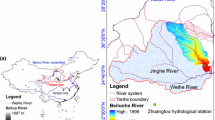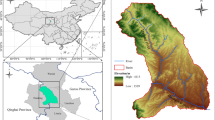Abstract
Nitrogen (N) and phosphorus (P) from non-point source (NPS) pollution in Nansi Lake Basin greatly influenced the water quality of Nansi Lake, which is the determinant factor for the success of East Route of South-North Water Transfer Project in China. This research improved Johnes export coefficient model (ECM) by developing a method to determine the export coefficients of different land use types based on the hydrological and water quality data. Taking NPS total nitrogen (TN) and total phosphorus (TP) as the study objects, this study estimated the contributions of different pollution sources and analyzed their spatial distributions based on the improved ECM. The results underlined that the method for obtaining output coefficients of land use types using hydrology and water quality data is feasible and accurate, and is suitable for the study of NPS pollution at large-scale basins. The average output structure of NPS TN from land use, rural breeding and rural life is 33.6, 25.9, and 40.5%, and the NPS TP is 31.6, 43.7, and 24.7%, respectively. Especially, dry land was the main land use source for both NPS TN and TP pollution, with the contributed proportions of 81.3 and 81.8% respectively. The counties of Zaozhuang, Tengzhou, Caoxian, Yuncheng, and Shanxian had higher contribution rates and the counties of Dingtao, Juancheng, and Caoxian had the higher load intensities for both NPS TN and TP pollution. The results of this study allowed for an improvement in the understanding of the pollution source contribution and enabled researchers and planners to focus on the most important sources and regions of NPS pollution.









Similar content being viewed by others
References
Arnold JG, Allen PM, Bernhardt G (1993) A comprehensive surface-groundwater flow model. J Hydrol 142:47–69
Beasley DB, Huggins LF, Monke EJ (1980) ANSWERS: a model for watershed planning. T Asabe 23:938–944
Bicknell BR, Imhoff JC, Jobes TH et al (2001) Hydrological simulation program-Fortran (HSPF version 12): user’s manual. EPA
Cai M, Li HE, Zhuang YT (2004) Application of improved output coefficient method to estimation of non-point source pollution load in river basin. J Hydraul Eng 35(7):40–45
Chang M, McBroom MW, Scott BR (2004) Roofing as a source of non-point water pollution. J Environ Manag 73:307–315
Cheng HG, Hao FH, Ren XY et al (2006) The study of the rate loss of nitrogenous non-point source pollution loads in different precipitation levels. Acta Sci Circumst 26(3):392–397
Ding XW, Shen ZY, Hong Q, Yang Z, Wu X, Liu R (2010) Development and test of the export coefficient model in the upper reach of the Yangtze River. J Hydrol 383:233–244
Farenga SJ, Daniel N (2007) Making a community information guide about non-point source pollution. Sci Scope 30:12–15
Fu B, Liu HB, Lu Y et al (2015) Study on the characteristics of nitrogen and phosphorus emission in the typical agricultural small watershed of plateau lake-a case study of Feng Yu River Watershed. J Environ Sci 35(9):2982–2899
Geng RZ, Wang XY, Wu ZX et al (2012) Non-point source pollution loads from the different land use types in the downstream areas of the Beiyun River basin China. J Agro-Environ Sci 31(7):1412–1420
Han LX, Huo F, Sun J (2011) Method for calculating non-point source pollution distribution in plain rivers. Water. Sci Eng 4(1):83–91
Huang YG, Fu LL, Hu XM (2012a) Study and application of export coefficient model of non-point source pollution load using in-situ data. J Hydroelectric Eng 31(5):159–162
Huang YL, Zhang L, Zhu CX (2012b) Survey and analysis of agricultural non-point source pollution in Nansi Lake Basin, Shandong Province. Res Environ Sci 25(11):1243–1249
Johnes PJ (1996) Evaluation and management of the impact of land use change on the nitrogen and phosphorus load delivered to surface waters: the export coefficient modelling approach. J Hydrol 183:323–349
Li G, Mao F (2008) Evaluation on non-point source pollution of soil and water loss and its economic loss of China. Soil Water Conserv China 2:9–11
Li HE, Zhuang YT (2003) Method research output coefficient prediction of non-point source nutrient loading progress and its application. J Xi'an Univ Technol 19(4):307–312
Li N, Han WZ, Shen MN et al (2016) Load evaluation of non-point source pollutants from reservoir based on export coefficient modeling. Trans CSAE 32(8):224–230
Lin XY, Jing YD (2014) Assessment and classified control of agricultural non-point source pollution in Nansihu Lake basin, Shandong province. Chinese. J Ecol 33(12):3278–3285
Liu J, Lu F, Yang YZ et al (2011a) Current status and control measures of agricultural non-point source pollution in Nansi Lake Watershed. China Popul Resour Environ 21(3):292–295
Liu YQ, Yang YL, Li FH (2011b) Estimation of pollution loads from agricultural non-point sources in Beijing region based on export coefficient modeling approach. Trans CSAE 27(7):7–12
Liu J, Lu F, Yang TZ et al (2012) Source apportionment of nitrogen and phosphorus from cropping non-point source pollution in Nansi Lake Basin. Environ Sci 33(9):3070–3075
Liu XL, Niu HB, Yan H et al (2013) Research and application of high-efficiency eco-engineering rural sewage treatment system. Trans CSAE 29(9):184–191
Liu ZJ, Zhang GC, Yang YH et al (2016) Study on the estimation and spatial distribution of agricultural non-point source pollution in Henan province. J Irrig Drain 35(11):1–6
Ma J, Chen X, Huang B, Shi Y, Chi G, Lu C (2015) Utilizing water characteristics and sediment nitrogen isotopic features to identify non-point nitrogen pollution sources at watershed scale in Liaoning Province, China. Environ Sci Pollut R 22(4):2699–2707
Min JS, Kong XZ (2016) Research progress of agricultural non-point source pollution. J Huazhong Agric Univ (Social Sci Ed) 2:59–66
Mostaghimi S, Younos TM, Tim US (1992) Crop residue effects on nitrogen yield in water and sediment runoff from two tillage systems. Agric, Ecosyst Environ 39:187–196
Noto LV, Ivanov VY, Bras RL, Vivoni ER (2008) Effects of initialization on response of a fully-distributed hydrologic model. J Hydrol 352:107–125
Ongley ED, Zhang X, Yu T (2010) Current status of agricultural and rural non-point source pollution assessment in China. Environ Pollut 158(5):1159–1168
Ouyang W, Skidmore AK, Toxopeus AG, Hao F (2010) Long-term vegetation landscape pattern with non-point source nutrient pollution in upper stream of Yellow River basin. J Hydrol 389:373–380
Ren W, Dai C, Guo HC (2015) Estimation of non-point source pollution load of Bao River basin in Yunnan Province based on improved output coefficient model. China Environ Sci 35(8):2400–2408
Schwarz GE, Hoos AB, Alexander RB, et al (2006) The SPARROW surface water-quality model theory, application, and user documentation. US Geological Survey techniques and methods report, book 6, chapter. Reston, VA, U.S. Dept. of the interior, U.S. Geological Survey. p. 248
Shandong Provincial Government (2016) Implementation scheme of manure treatment and utilization in agricultural breeding in Shandong province
Shen ZY (2008) Characteristics and variation of non-point source pollution in the upper reaches of the Yangtze River. Science Press, Beijing
Shen J, Zhang ZL, Yang LY et al (2008) The study of environment and resources. Seismological Press, Beijing
Shi ZH, Cai CF, Ding SW (2002) Study on nitrogen and phosphorus load of agricultural non-point source phosphorus in the middle and lower reaches of Hanjiang River. Chinese J Environ Sci 22(4):473–477
Soranno P, Hubler S, Carpenter S et al (1996) Phosphorus loads to surface waters: a simple model to account for spatial pattern of land use. Ecol Appl 6(3):865–878
Sun B, Zhang LX, Yang LZ, Zhang F, Norse D, Zhu Z (2012) Agricultural non-point source pollution in China: causes and mitigation measures. Ambio 41:370–379
Wang WL, Ju TT, Dong WP et al (2015) Analysis of non-point source pollution and water environmental quality variation trends in the Nansi Lake Basin from 2002 to 2012. J Chem-NY 2015:1–10
Wei YN, Zhang K, Zhang BL (2013) Effects of water pollutant emission standard in watersheds of South-to-North Water Diversion Project on economy of cities along the water transfer line in Shandong province. Divers Water Conserv Technol 11(2):81–84
Whittemore RC (1998) The BASINS model. Water Environ Technol 10:57–61
Williams JR, Nicks AD, Arnold JG (1985) Simulator for water resources in rural basins. J Hydraul Eng-ASCE 111:970–986
Wu L, Gao JE, Ma XY, Li D (2015) Application of modified export coefficient method on the load estimation of non-point source nitrogen and phosphorus pollution of soil and water loss in semiarid regions. Environ Sci Pollut R 22(14):10647–10660
Xia J, Zhai XY, Zhang YY (2012) Progress of research on non-point source pollution model of water environment. Progr Geogr Sci 31(7):941–952
Xu QG, Xi BD, Cao JL (2013) Lake eutrophication in China and its regional differences. Science Press, Beijing
Xu LH, Chen CG, Hu B et al (2015) Improvement of export coefficient model for N and P based on rainfall intensity and its application. Trans CSAE 31(16):159–166
Yong RA, Onstad CA, Bosch DD et al (1989) AGNPS: a non-point source pollution model for evaluating agricultural watersheds. J Soil Water Conserv 44:168–173
Yuan CC, Liu LM, Ye JW (2017) Assessing the effects of rural livelihood transition on non-point source pollution: a coupled ABM-IECM model. Environ Sci Pollut R 24(14):12899–12917
Zhang YH, Liu DD, Xu Z et al (2010) Monitoring method of generation and emission coefficients of rural domestic waster in key basins. J Agro-Environ Sci 29(4):785–789
Zhang LK, Xiang B, Hu Y et al (2014) Risk assessment of non-point source pollution in Hulan River Basin using an output coefficient model. J Agro-Environ Sci 33(1):148–154
Zhang BL, Yin L, Zhang SM et al (2016) GIS and L-THIA based analysis on variations of non-point pollution in Nansi Lake Basin, China. J Donghua Univ (Eng Ed) 3396:851–858
Zhao YH, Deng XZ, Zhan JY et al (2010) Research progress of Lake eutrophication control and control strategy in China. Environ Sci Technol 33(3):92–98
Zhou YL, Wang HJ, Yu H et al (2014) Estimation of nutrient export loads in Taihu Lake watershed based on the export coefficient model. Acta Agric Univ Jiangxiensis 36(3):678–683
Zhu D, Chang J (2008) Annual variations of biotic integrity in the upper Yangtze River using an adapted index of biotic integrity (IBI). Ecol Indic 8:564–572
Zhu QD, Sun JH, Hua GF, Wang JH, Wang H (2015) Runoff characteristics and non-point source pollution analysis in the Taihu Lake Basin: a case study of the town of Xueyan, China. Environ Sci Pollut R 22(19):15029–15036
Acknowledgments
The authors wish to gratefully acknowledge Environmental Science and Pollution Research, as well as the anonymous reviewers who helped to improve this paper through their thorough review.
Funding
This research was supported by the National Natural Science Foundation of China (No. 41401663), Shandong Provincial Natural Science Foundation, China (No.ZR2016EEM18), and the Excellent Young Scholars Research Fund of Shandong Normal University.
Author information
Authors and Affiliations
Corresponding authors
Ethics declarations
Conflict of interest
The authors declare that they have no conflict of interest.
Additional information
Responsible editor: Marcus Schulz
Electronic supplementary material
ESM 1
(XLSX 20 kb)
Rights and permissions
About this article
Cite this article
Zhang, Bl., Cui, Bh., Zhang, Sm. et al. Source apportionment of nitrogen and phosphorus from non-point source pollution in Nansi Lake Basin, China. Environ Sci Pollut Res 25, 19101–19113 (2018). https://doi.org/10.1007/s11356-018-1956-8
Received:
Accepted:
Published:
Issue Date:
DOI: https://doi.org/10.1007/s11356-018-1956-8




